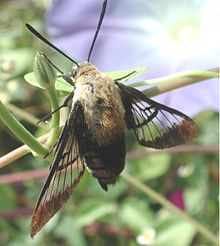The hummingbird moth that is commonly mistaken for a hummingbird:
The Hummingbird moth (Macroglossum stellatarum) is a species of hawk moth with a long proboscis, and is capable of hovering in place, making an audible humming noise. These two features make it look remarkably like a hummingbird when it feeds on flowers. The forewings of the hummingbird moth are brown and the hind wings are orange. The wingspan is 50-58 mm.
Hemaris is a Holarctic genus of moths in the sphingidae family, consisting of about 17 species, four of which fly in North and South America. Their main host plants are herbs and shrubs of the Dipsacaceae (Teasel) and Caprifoliaceae (Honeysuckle) families. Moths in the Hemaris genus are collectively called clearwing moths or hummingbird moths in the US, and Bee Hawk-Moths in Britain.
| Hemaris | ||||||||||||||
|---|---|---|---|---|---|---|---|---|---|---|---|---|---|---|
 this image Licensed under the terms of the GNU Free Documentation License Hemaris diffinis
Lake Junaluska, North Carolina |
||||||||||||||
| Scientific classification | ||||||||||||||
|
||||||||||||||
| Hemaris affinis Hemaris alaiana Hemaris beresowskii Hemaris croatica Hemaris dentata Hemaris diffinis Hemaris ducalis Hemaris fuciformis Hemaris gracilis Hemaris ottonis Hemaris radians Hemaris rubra Hemaris saundersi Hemaris senta Hemaris staudingeri Hemaris thysbe Hemaris tityus |
Form
Eggs are small, spherical, and pale glossy green in color.
The larvae are small, cylindrical, and granulose. The granules often have small bristles. While most larvae are green and brown, many color forms exist. All have a distinctive pale dorso-lateral longitudinal stripe from head to horn.
Pupae are enclosed in a loosely spun cocoon, and are glossy in most species. There is a prominent tubercle, or hook, alongside each eye. The cremaster is large, and flattened.
The imagos, or adults, are small, diurnal moths that resemble bumble bees in shape. They are often times mistaken for hummingbirds, which is why their common name is hummingbird moths. The forewings have hyaline areas or are fully scaled. The species with hyaline areas are initially with covered scales, but these are shed during their first flight. The antennae are strongly clubbed in both sexes, with a small recurved hook at the end. The abdomen ends in a large fan-tail of setae which resembles a lobster tail.
The genitalia of the male are asymmetrical, having the uncusdivided and the two lobes subequal, heavily sclerotized with a rounded apex. The ostium bursae of the female is angled to the left.
click on the play button below to see video of a Hamaris moth
Click Wikipedia, the free encyclopedia, to view original editable article – All text is available under the terms of the GNU Free Documentation License

